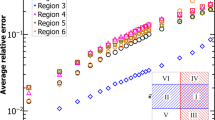Abstract
In this paper, we investigate the synchronizability of two-layer networks according to the master stability method. We define three particular couplings: positively correlated, randomly correlated and negatively correlated couplings. When the inter-layer coupling strength is fixed, negatively correlated coupling leads to the best synchronizability of a two-layer network, and synchronizability of networks with randomly and positively correlated couplings follow consecutively. For varying inter-layer coupling strength, the trend of network synchronizability with an unbounded synchronous region differs from that with a bounded one. If the synchronous region is unbounded, synchronizability of the two-layer network keeps enhancing, but it has a threshold. If the synchronous region is bounded, the synchronizability of the two-layer network keeps improving until the inter-layer coupling strength reaches a certain value, and then the synchronizability gets weakened with ever-increasing inter-layer coupling strength. To summarise, there exists an optimal value of the inter-layer coupling strength for maximising synchronizability of two-layer networks, regardless of the synchronous region types and coupling patterns. The findings provided in this paper shed new light on understanding synchronizability of multilayer networks, and may find potential applications in designing optimal inter-layer couplings for synchronization of two-layer networks.
Similar content being viewed by others
References
G. D’Agostino, A. Scala, Networks of Networks: the last Frontier of Complexity (Springer, Berlin, 2014)
P.J. Mucha, T. Richardson, K. Macon, M.A. Porter, J.P. Onnela, Science 328, 5980 (2010)
R. Gutiérrez, I. Sendiñna-Nadal, M. Zanin, D. Papo, S. Boccaletti, Sci. Rep. 2, 396 (2012)
G. Bianconi, Phys. Rev. E 87, 6 (2013)
S. Gómez, A. Díaz-Guilera, J. Gómez-Gardeñes, C.J. Pérez-Vicente, Y. Moreno, A. Arenas, Phys. Rev. Lett. 110, 2 (2013)
C. Granell, S. Gomez, A. Arenas, Phys. Rev. Lett. 111, 12 (2013)
A. Sole-Ribalta, M. De Domenico, N.E. Kouvaris, A. Díaz-Guilera, S. Gómez, A. Arenas, Phys. Rev. E 88, 3 (2013)
J. Gómez-Gardeñes, I. Reinares, A. Arenas, L.M. Floría, Sci. Rep. 2, 620 (2012)
J. Gómez-Gardeñes, C. Gracia-Lázaro, L.M. Floría, Y. Moreno, Phys. Rev. E 86, 5 (2012)
J. Aguirre, R. Sevilla-Escoboza, R. Gutiérrez, D. Papo, J.M. Buldú, Phys. Rev. Lett. 112, 24 (2014)
J. Um, P. Minnhagen, B.J. Kim, Chaos 21, 2 (2011)
R. Lu, W. Yu, J. Lü, A. Xue, IEEE T. Neur. Net. Lear. 25, 11 (2014)
H. Zhang, X. Wang, X. Lin, IEEE/ACM T. Comput. Bi. 11, 5 (2014)
C. Luo, X. Wang, H. Liu, Sci. Rep. 4, 7522 (2014)
C. Luo, X. Wang, H. Liu, Chaos 24, 3 (2014)
M. Kivelä, A. Arenas, M. Barthelemy, J.P. Gleeson, Y. Moreno, M.A. Porter, J. Com. Net. 2, 3 (2013)
S. Boccaletti, G. Bianconi, R. Criado, C.I. del Genio, J. Gómez-Gardeñes, M. Romance, I. Sendiña-Nadal, Z. Wang, M. Zanin, Phys. Rep. 544, 1 (2014)
A.L. Barabási, R. Albert, Science 286, 5439 (1999)
X.F. Wang, X. Li, G. Chen, Complex Networks Theory and its Application (Tsinghua University Press, Beijing, 2006)
L.M. Pecora, T.L. Carroll, Phys. Rev. Lett. 80, 10 (1998)
L. Tang, J.-A. Lu, J. Lü, X. Yu, Int. J. Bifurc. Chaos 22, 11 (2012)
L. Tang, J.-A. Lu, J. Lü, X. Wu, Int. J. Bifurc. Chaos 24, 1 (2014)
B. Mohar, Y. Alavi, G. Chartrand, O. Oellermann, Graph Theory, Combinatorics, and Applications 18, 7 (1991)
G. Chen, The Theory and Application of Matrix (Science Press, Beijing, 2007)
C.W. Wu, Phys. Lett. A 319, 5 (2003)
Y.Y. Gao, J.-A. Lu, Complex Systems and Complexity Science 9, 3 (2012)
S.J. Wang, X.J. Xu, Z.X. Wu, Y.H. Wang, Phys. Rev. E. 74, 4 (2006)
A.E. Motter, S.A. Myers, M. Anghel, T. Nishikawa, Nat. Phys. 9, 3 (2013)
A. Díaz-Guilera, J. Gómez-Gardeñes, Y. Moreno, M. Nekovee, Int. J. Bifurc. Chaos 19, 2 (2009)
Author information
Authors and Affiliations
Corresponding author
Rights and permissions
About this article
Cite this article
Xu, M., Zhou, J., Lu, Ja. et al. Synchronizability of two-layer networks. Eur. Phys. J. B 88, 240 (2015). https://doi.org/10.1140/epjb/e2015-60330-0
Received:
Revised:
Published:
DOI: https://doi.org/10.1140/epjb/e2015-60330-0




